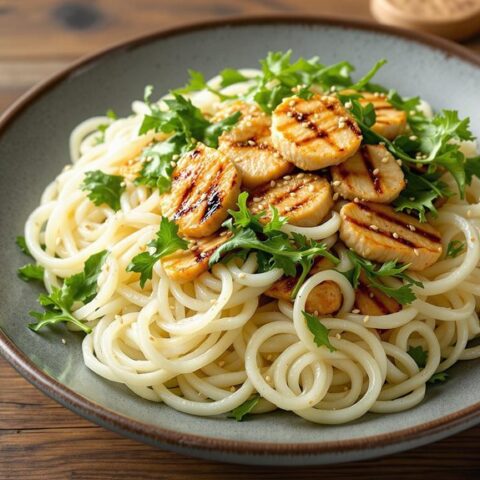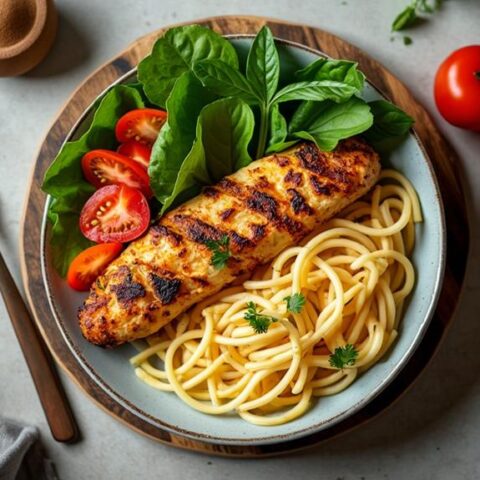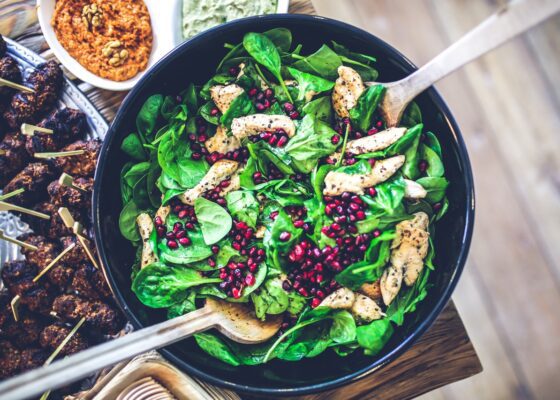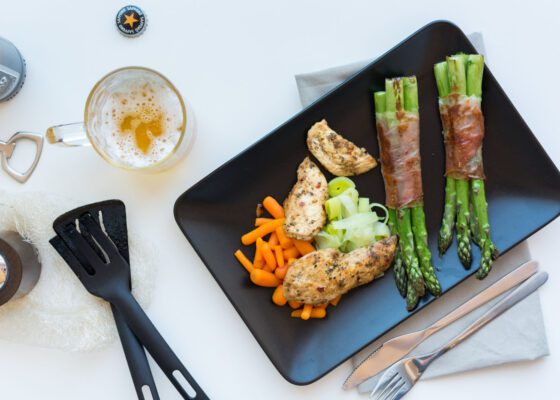
Low-carb pasta alternatives can be made using ingredients like almond flour, coconut flour, or konjac root instead of wheat flour. A basic recipe combines three room temperature eggs with softened cream cheese, enhanced with alternative flours and olive oil. The mixture is spread on a lined baking sheet, baked at 350°F for 10 minutes, then shaped into pasta forms. These alternatives contain only 5-6 grams of carbs per serving, making them ideal for those seeking healthier pasta options. The techniques for creating perfect low-carb pasta textures await exploration.
Key Takeaways
- Replace wheat flour with almond flour, coconut flour, or psyllium husk powder to create a low-carb pasta base.
- Combine three room temperature eggs with cream cheese as your protein-rich foundation for homemade keto pasta.
- Use shirataki noodles made from konjac root for a ready-made option containing only 5-6 grams of carbs per serving.
- Cool cooked pasta to increase resistant starch content and enhance insulin sensitivity while maintaining texture.
- Pair pasta with cream-based sauces, pesto, or avocado-based alternatives instead of high-carb tomato sauces.
Understanding Traditional vs. Low-Carb Pasta Options
Most pasta enthusiasts seeking to reduce their carbohydrate intake face an essential decision between traditional wheat-based pasta and modern low-carb alternatives.
While conventional pasta contains significant amounts of carbohydrates from wheat flour, low-carb pasta options utilize alternative ingredients like almond flour, coconut flour, and konjac root to achieve similar textures with fewer carbs.
The difference in carbohydrate content is substantial, with options like shirataki noodles containing only 5-6 grams of carbs per serving, primarily from soluble fiber.
Although cooling traditional pasta can increase its resistant starch content and help manage blood sugar levels, this method doesn't match the carb-reducing benefits of specialized alternatives.
Low-carb pasta varieties offer versatile meal options while supporting stable blood sugar levels and weight management goals.
For those following a keto diet, zucchini noodles are an excellent choice due to their low carbohydrate content and high vitamin and antioxidant levels.
Essential Ingredients for Homemade Keto Pasta
Creating successful keto pasta begins with selecting the right foundational ingredients, including room temperature eggs, firm cream cheese, and finely milled psyllium husk powder.
The quality and precise measurements of these base ingredients greatly impact the final texture and taste of the pasta, making ingredient selection a critical first step.
While specialized pasta-making tools can enhance the process, the most essential equipment includes basic kitchen items such as mixing bowls, measuring tools, and a reliable rolling pin or pasta machine.
Base Ingredients Matter Most
The foundation of successful low-carb pasta lies in selecting the right combination of base ingredients, which serve as critical building blocks for texture and structure. Room temperature eggs and firm cream cheese form the essential protein base, while psyllium husk powder provides the necessary binding properties that traditional wheat flour would typically offer.
When crafting low-carb alternatives, base ingredients matter most in determining the final product's quality. Apple cider vinegar strengthens the pasta's structure, while parmesan cheese serves as an excellent flour substitute.
For those preferring grain-free options, almond flour offers a neutral taste profile, though coconut flour presents a viable alternative when additional moisture is incorporated. Thorough blending of these components guarantees a consistent dough that performs reliably during cooking.
Tools For Perfect Results
Every successful low-carb pasta recipe requires specific tools and ingredients to achieve professional-quality results in the home kitchen. While a pasta machine helps create uniform strands, the key components include room temperature eggs for proper texture and firm cream cheese, particularly Philadelphia brand, which provides structural stability without excess moisture.
Essential tools extend beyond equipment to include important ingredients like psyllium husk powder, which acts as a significant thickening agent. Apple cider vinegar strengthens the pasta's resilience, especially important when cooking with sauces.
When incorporating alternative flours such as almond or coconut varieties, precise measurements become critical due to their varying moisture contents. Having the right tools and ingredients guarantees consistent results and helps maintain the pasta's integrity throughout preparation and cooking.
Basic Recipe Steps and Cooking Techniques
Making low carb pasta starts with a simple mixture of three room temperature eggs combined thoroughly with softened cream cheese, creating the foundation for this keto-friendly alternative.
The mixture is enhanced with either almond flour, coconut flour, or parmesan cheese, along with a teaspoon of olive oil for improved texture and handling.
The preparation continues with spreading the mixture evenly on a lined baking sheet, followed by baking at 350°F for exactly 10 minutes.
After cooling for 10 minutes, the pasta can be shaped into various forms like spaghetti or fettuccine.
For convenience, the prepared pasta can be stored in the refrigerator for up to three days, or frozen for extended storage, making it an excellent option for meal planning and preparation.
Including psyllium husk powder can help improve the texture of the pasta, providing a more traditional pasta feel.
Tips for Achieving Perfect Pasta Texture
Achieving the perfect texture in low-carb pasta requires careful attention to cooking times, with ideal al dente consistency typically occurring 1-2 minutes before traditional pasta timing.
The balance of moisture content proves critical, as excess moisture can lead to mushiness while insufficient moisture results in a dry, brittle texture that breaks easily.
Proper storage in an airtight container, with parchment paper between layers, helps maintain the desired texture and prevents the pasta from becoming too soft or developing unwanted moisture during refrigeration.
Al Dente Cooking Time
Mastering al dente pasta texture requires precise timing and careful attention to the cooking process. For best results, reduce the cooking time by 1-2 minutes from the package instructions, as pasta continues to cook slightly after draining.
Using a large pot of well-salted boiling water helps maintain the pasta's desired firmness and guarantees even cooking throughout.
When preparing low-carb pasta alternatives, the al dente cooking time typically requires closer monitoring, as these varieties often cook more quickly than traditional pasta.
To determine doneness, taste-test the pasta for a tender yet firm bite with slight resistance in the center.
Once the perfect al dente texture is achieved, immediately rinse the pasta under cold water to halt the cooking process and preserve its ideal texture before incorporating it into dishes.
Balancing Moisture Content
The delicate balance of moisture content stands as an essential factor in crafting successful low-carb pasta. Using firm cream cheese provides structural integrity while maintaining optimal moisture levels, preventing the dough from becoming overly wet during preparation.
Room temperature eggs play a vital role in achieving the perfect balance, helping to emulsify ingredients while avoiding excess moisture.
To maintain ideal moisture content, precise measurements of alternative flours, such as almond or coconut, are significant. Additionally, incorporating psyllium husk powder helps absorb any excess moisture, resulting in a firmer pasta structure.
After preparation, allowing the pasta to cool briefly enables moisture to distribute evenly throughout the dough, creating an ideal texture that's easier to shape and handle during the final stages of pasta making.
Proper Storage Methods
Proper storage plays an essential role in preserving the texture and quality of low-carb pasta preparations. Following proper storage methods guarantees good pasta maintains its desired consistency and taste for extended periods. Short-term storage requires an airtight container in the refrigerator, while long-term preservation calls for freezer storage with minimal air exposure.
| Storage Method | Recommended Practice |
|---|---|
| Refrigeration | Airtight container, up to 5 days |
| Freezing | Ziplock bag, remove air, several months |
| Pre-storage | Rinse with cold water, separate strands |
| Reheating | Use hot, non-oiled pan for 1 minute |
| Sauce Assembly | Add just before serving |
For best results, store unsauced pasta separately and combine with sauce only when ready to serve, preventing unwanted moisture absorption that could compromise texture.
Measuring and Portion Control Guidelines
Successful portion control begins with accurate measurement techniques that help maintain the right balance of low-carb pasta in meals.
Using a casserole dish to create a single layer of pasta provides precise serving measurements, supporting weight loss goals through controlled portions. Breaking long pasta in half not only makes it easier to manage but also helps prevent overserving.
Selecting thinner varieties of pasta, such as capellini or thin spaghetti, naturally reduces carbohydrate content while maintaining satisfying portion sizes.
For ideal results, consider batch cooking and chilling pasta to increase its resistant starch content. This method, combined with mindful eating practices like measuring individual servings, helps regulate blood sugar levels and prevents overconsumption.
Incorporating a variety of low-carb vegetables such as leafy greens or broccoli into pasta dishes can enhance nutritional value while keeping carbohydrate intake in check.
These measuring and portion control guidelines guarantee consistent, health-conscious pasta servings.
Storing and Reheating Low-Carb Pasta
Low-carb pasta requires specific storage methods to maintain its unique texture and consistency over time, with properly stored portions lasting up to five days in the refrigerator or several months in the freezer.
Effective storage starts with rinsing the cooled pasta to prevent clumping, followed by placing it in an airtight container or ziplock bag, depending on the intended storage duration.
When it comes time to reheat, incorporating the pasta directly into a warm sauce provides ideal results while potentially enhancing its resistant starch benefits.
Proper Storage Methods
When storing homemade pasta alternatives, implementing correct storage techniques can greatly extend shelf life and maintain the desired texture. Proper storage methods not only preserve freshness but also enhance the formation of resistant starch, which helps regulate blood sugar levels when the pasta is consumed.
- Allow pasta to cool completely in the refrigerator before storing.
- Place in an airtight container or ziplock bag and refrigerate for up to 5 days.
- For freezing, spread pasta flat in freezer bags to prevent clumping.
- Thaw frozen pasta overnight in the refrigerator before use.
Remember to reheat only the portion needed, as multiple reheating cycles can compromise texture.
When reheating, add the cold pasta directly to sauces, which allows it to warm gradually while absorbing flavors.
Best Reheating Techniques
Proper reheating techniques play an essential role in preserving both the texture and nutritional benefits of low-carb pasta alternatives.
After cooling cooked pasta in the refrigerator, which enhances its resistant starch content, reheating can be done effectively using either a microwave or stovetop method with a small amount of water to maintain moisture.
For the best reheating techniques, consider adding extra vegetables or protein during the warming process to create a more nutritious meal. This approach not only enhances flavor but also helps maintain stable blood sugar levels, as reheated low-carb pasta can reduce blood sugar spikes by up to 50% compared to freshly cooked pasta.
When stored properly in an airtight container, the pasta remains suitable for reheating for up to five days while retaining its beneficial resistant starch properties.
Best Sauce Pairings for Keto Pasta
Delectable sauces can transform keto pasta from a simple base into a memorable meal, with several options that maintain low-carb requirements while maximizing flavor.
From classic Italian-inspired choices to modern alternatives, these sauces complement low-carb pasta varieties while keeping carbohydrate content minimal.
- Cream-based sauces like Alfredo and carbonara provide rich, satisfying flavors without adding significant carbs.
- Fresh pesto, combining basil, garlic, olive oil, and nuts, offers a vibrant, herb-forward option.
- Low-sugar tomato-based sauces deliver traditional pasta satisfaction when carefully selected.
- Simple garlic butter sauce, enhanced with fresh herbs, creates an elegant dish while maintaining keto compliance.
For additional variety, consider incorporating an avocado-based sauce, which adds healthy fats and creates a creamy texture perfect for keto pasta dishes.
To enhance the sweetness of some sauces without disrupting ketosis, consider using keto-friendly sweeteners like stevia or erythritol for a subtle, low-carb sweetness.
Alternative Flours and Their Properties
Understanding alternative flours forms the foundation of successful low-carb pasta making, as these ingredients provide the structure and nutritional benefits essential for keto-friendly recipes. Almond flour and coconut flour stand out as popular options, each offering distinct properties and advantages. Almond flour contains approximately 10 grams of carbs per quarter cup while delivering 6 grams of protein, making it a nutrient-dense choice. Coconut flour, with only 6 grams of carbs per two tablespoons, requires special attention to liquid ratios, typically needing one cup of liquid for every quarter cup of flour. Both alternatives are naturally gluten-free and can be enhanced with binders like eggs or psyllium husk powder to improve texture and structure in pasta recipes. Additionally, using healthy oils such as avocado oil can enhance the nutritional quality of your pasta dishes while maintaining a keto-friendly profile.
Tools and Equipment Needed
Creating successful low-carb pasta requires a specific set of tools and equipment that greatly impact the final texture and quality of the dish. The right tools guarantee consistent results and make the preparation process more efficient.
Essential equipment for making low-carb pasta includes:
- A high-quality blender or food processor for combining ingredients smoothly, especially when working with eggs and cream cheese.
- Measuring cups and spoons for precise portioning of alternative flours and other ingredients.
- A silicone baking mat or parchment paper to prevent sticking and enable easy removal after baking.
- A sharp knife or pasta cutter for achieving clean cuts when shaping the pasta.
Additionally, a non-stick frying pan proves invaluable for drying the noodles or reheating them in sauce, guaranteeing ideal texture and preventing unwanted sticking during the final preparation stages.
Common Mistakes to Avoid
While making low-carb pasta can be rewarding, several common pitfalls can derail even the most well-intentioned efforts to create a healthier alternative. A vital mistake is selecting regular wheat pasta instead of lower carb pasta options like shirataki noodles or homemade keto variations. Imprecise portion control often leads to excessive carbohydrate intake, making it essential to use proper measuring techniques, such as spreading pasta in a single layer in a casserole dish. Many cooks overlook the importance of incorporating vegetables, which can enhance fiber content while reducing overall carb density. Additionally, failing to leverage the benefits of cooking and cooling pasta means missing out on resistant starch formation, which helps manage blood sugar levels and increases satiety when reheating leftovers. It's important to avoid starchy vegetables such as potatoes and corn, which can unexpectedly increase the carbohydrate content of a dish.
Nutritional Benefits and Macros
The nutritional profile of low-carb pasta alternatives offers substantial benefits for those seeking to reduce their carbohydrate intake while maintaining satisfying meals.
These options, including keto pasta recipe variations, provide an excellent balance of macronutrients while supporting blood sugar management and digestive health.
Keto pasta alternatives deliver optimal macronutrient ratios, helping maintain stable blood sugar levels while supporting digestive wellness.
- Each serving contains only 5-6 grams of carbohydrates, primarily from beneficial soluble fiber.
- Higher protein content of approximately 8 grams per serving supports muscle maintenance and satiety.
- Healthy fats, averaging 15 grams per serving, provide sustained energy throughout the day.
- Resistant starch content, particularly in cooled preparations, enhances insulin sensitivity and promotes gut health.
Incorporating keto-friendly vegetables such as spinach and kale can further enhance the nutritional value of low-carb pasta dishes by adding essential vitamins and fiber without disrupting low-carb goals.
The combination of these nutritional elements creates a well-rounded meal option that aligns with low-carb dietary goals while delivering essential nutrients and promoting overall health benefits.
Meal Planning With Low-Carb Pasta
Successful meal planning with low-carb pasta requires thoughtful preparation and strategic ingredient combinations to maintain ketogenic or low-carb dietary goals. Incorporating resistant starch-rich ingredients and balancing meals with protein, healthy fats, and fiber helps stabilize blood sugar levels while ensuring satisfaction. Effective meal prep techniques include batch cooking low-carb pasta alternatives like shirataki noodles and pre-portioning servings for controlled consumption. Adding diverse, colorful vegetables enhances nutritional value without greatly impacting carbohydrate content. To maintain ketosis, focus on low-carb vegetables like spinach, broccoli, and cauliflower. Planning should aim to include approximately 20 grams of resistant starch daily through ingredients such as cooled pasta, potatoes, and beans. This systematic approach to meal planning allows for quick preparation of nutritious low-carb pasta dishes while maintaining dietary compliance and promoting mindful eating habits.
Recipe Variations and Modifications
Creating versatile low-carb pasta recipes requires understanding key ingredient substitutions and modifications that maintain ketogenic compliance while delivering satisfying results.
Home chefs can explore multiple recipe variations by adjusting core ingredients and preparation methods to suit their preferences.
- Base ingredients can alternate between almond flour (4 tablespoons) or coconut flour (2 tablespoons), combined with three eggs and cream cheese.
- A flourless variation using parmesan cheese creates an equally satisfying texture.
- Flavor modifications include turmeric for color or garlic powder for enhanced taste.
- Shape variations are achievable by cutting the cooled pasta into spaghetti, fettuccine, or lasagna strips.
These modifications allow for experimentation with baking times and temperatures, ensuring ideal browning and texture while maintaining keto-friendly principles throughout all variations. Additionally, almond flour serves as a primary ingredient in many low-carb recipes, providing both a reduction in carbs and nutritional benefits.
Frequently Asked Questions
How to Cook Pasta to Reduce Carbs?
Cook pasta until al dente, refrigerate overnight, then reheat before serving. This process creates resistant starches. Consider pasta alternatives like zucchini noodles and incorporate vegetables to reduce overall carbohydrate content.
How to Eat Pasta on a Low-Carb Diet?
Low-carb dieters can enjoy pasta by choosing alternatives like shirataki noodles, measuring smaller portions, combining with vegetables, and selecting thin noodles to reduce overall carbohydrate content while maintaining satisfaction.
Is Low-Carb Pasta Good for Weight Loss?
Low-carb pasta supports weight loss by reducing overall calorie and carbohydrate intake. Its high fiber content promotes satiety, while helping maintain stable blood sugar levels and encouraging fat burning.
What Is the Lowest Carb Pasta?
Among pasta alternatives, shirataki noodles contain the lowest carbohydrates at 5-6 grams per serving, followed by zucchini noodles at 4 grams per cup and egg-based keto pasta with minimal carbs.
Conclusion
Making low-carb pasta at home provides a satisfying alternative for those following ketogenic or low-carb diets. With the right ingredients, techniques, and attention to detail, anyone can create pasta dishes that rival traditional versions while maintaining their health goals. By understanding proper portioning, avoiding common pitfalls, and experimenting with different variations, home cooks can enjoy pasta dishes that align with their dietary needs without sacrificing taste or texture.









No Comments